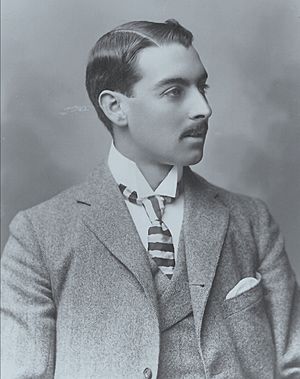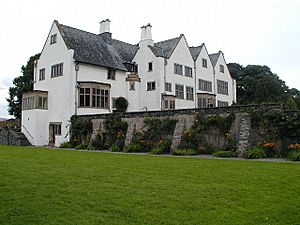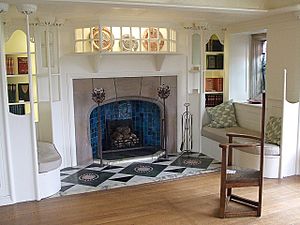Baillie Scott facts for kids
Quick facts for kids
Baillie Scott
|
|
|---|---|
 |
|
| Born |
Mackay Hugh Baillie Scott
23 October 1865 Beards Hill, St Peter's, Broadstairs, Kent, England
|
| Died | 10 February 1945 (aged 79) Elm Grove Hospital, Brighton, Sussex, England
|
| Occupation | Architect |
| Known for | Blackwell house |

Mackay Hugh Baillie Scott (born October 23, 1865, died February 10, 1945) was a famous British architect and artist. He designed buildings in many different styles during his long career. He was especially known for his Arts and Crafts designs. This style focused on simple forms and good craftsmanship.
Contents
Early Life and Education
Baillie Scott was born in Kent, England, in 1865. He was the second of ten children. His father was a wealthy landowner from Scotland.
He first studied at the Royal Agricultural College in Cirencester. After finishing there in 1885, he decided to become an architect instead. He briefly studied architecture in Bath.
Life on the Isle of Man
A very important part of his architectural journey was the 12 years he spent living on the Isle of Man. For the first four years, he lived in Douglas. In 1893, he moved into a house he had designed himself. This house was called Red House.
Career as an Architect
Baillie Scott started his career working with Fred Saunders. They had studied together at the Isle of Man School of Art. In May 1891, Baillie Scott also worked as an art teacher. During this time, he became good friends with another designer, Archibald Knox.
Later, Baillie Scott opened his own architecture business. In 1894, he wrote an article for The Studio magazine. In this article, he shared his ideas for an "ideal house."
The Ideal House Concept
His "ideal house" design featured a tall central hall. It had a special gallery and a cozy inglenook fireplace area. This main hall was connected to the living and dining rooms. These rooms could be separated by folding screens. This clever design became very popular. It brought him many new projects.
Arts and Crafts Style
Baillie Scott developed his own unique Arts and Crafts style. This style focused on simple, honest architecture. It meant using materials in a natural way. It also emphasized excellent craftsmanship. He believed that buildings should be both beautiful and useful.
He was known for paying close attention to both the outside and inside of his buildings. He designed nearly 300 buildings throughout his career.
Famous Buildings
Here are some of the notable buildings Baillie Scott designed:
- Bexton Croft, Knutsford, Cheshire, 1896
- Blackwell, Bowness, Cumbria, 1898–1900
- The White House, Helensburgh, Scotland, 1899
- Home Close, Sibford Ferris, Oxfordshire, 1911
- Snowshill Manor gardens, 1920–23
- Church Rate Corner (a private house), Cambridge, 1924
- Oakhams, 1942 (additions to his own home)
- Red House, Isle of Man (his own home)
- Woodbury Hollow, Loughton, Essex
- Winscombe House, Crowborough, Sussex
- Sandford House, Kilmany, Fife, Scotland
- White Lodge, Wantage, Oxfordshire
- Chludzinski's Mansion, Lieskavičy, Šumilina district, Vitebsk region, Belarus
Family and Later Life
Baillie Scott married Florence Kate Nash on February 1, 1899. They had two children:
- A daughter, Enid Maud Mackay Baillie-Scott, born in 1889.
- A son, Mackay Hugh Baillie-Scott, born in 1891.
He passed away in Brighton, England, in 1945. His gravestone has a special message: "Nature he loved and next to nature art." This shows how much he loved both the natural world and creating beautiful things.



